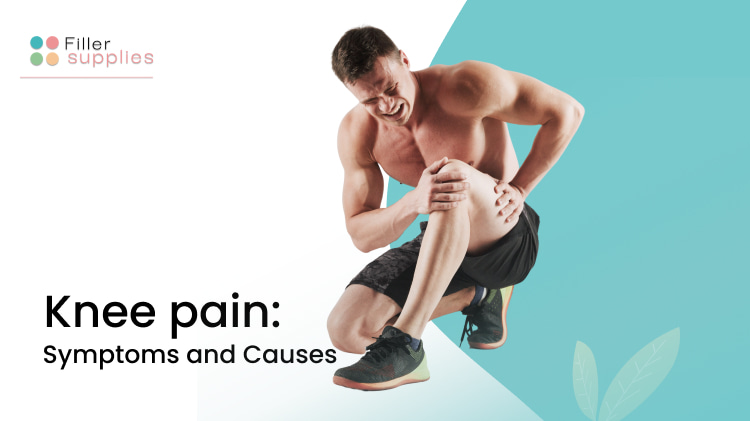Knee Pain: Symptoms and Causes

Difficulty walking, limping, and locking of the knee are among the numerous knee pain symptoms. These days, this incredibly unpleasant health condition is widely spread all around the world. And, frankly speaking, there exists a great number of reasons that cause knee pain.
Want to know more? Well, keep reading this article, as we are going to discuss knee pain from A to Z. Namely, we will cover its main symptoms, causes, and options of how to get rid of it (including physical therapies, medications, orthopedic injections, and surgeries). So, let’s start right away!
A Few Words on Knee Pain
Before delving into the details of knee pain, it might be useful to first take a closer look at the nature of the human knee. Thus, let us make a small detour to its peculiarities and anatomy.
So, what exactly is the human knee? Well, it is one of the most complicated joints in the human body that joins the femur to the tibia (or, in other words, the thigh bone to the shin bone). Another key bone in the anatomy of the knee is the kneecap (together with the cartilage under it). It is because of powerful ligaments and tendons that the thigh bone, the shin bone, and the kneecap are held together.
Mindblowing knee-related fact #1. Similar to fingerprints, each and every person has unique kneecaps.
The range of motion of the knee is pretty limited, mainly due to its anatomy. On average, it has about 120 degrees of flexion and a small degree of rotation.
Due to the fact that the knee is actively involved in the process of walking, it is one of the most stressed joints in the human body. Each time a person runs, jumps, or simply climbs the stairs, a knee joint functions as a shock absorber to make the move as smooth as possible.
Mindblowing knee-related fact #2. The functioning of the knee relies on ten muscles.
Main Symptoms of Knee Pain
The painful knee is an unpleasant health condition that might be characterized by a whole bunch of symptoms. Below, you will find the list of the most widely-spread ones:
- The inability of the full leg straightening;
- The stiffness of the knee joint;
- The crunching noise in the knee while moving;
- The overall weakness or instability of the knee;
- Redness around the area of the knee;
- Swelling;
- Etc.
Please note that the above-mentioned symptoms of the sore knee are merely generalized ones. However, they might substantially vary depending on the main reason that causes knee problems.
The nature of knee pain might also vary a lot. A person might experience either temporary or chronic knee pain. As well, its density might vary from minor to severe.
Moreover, there exists a range of additional signs that accompany knee pain. In some cases, a person who suffers from this health condition might also have:
- Deformity of the knee;
- Warm to the touch knee area;
- Fever;
- Etc.
As well, it might become either difficult or impossible for a person with knee pain to bear weight on their knee. Or the unpleasant feeling might spread to other parts of the leg.
Mindblowing knee-related fact #3. It is because of the anatomy of human knees that people can walk on two feet.
Top Causes of Knee Pain
Believe us or not, there exists a great number of factors that might cause minor, medium, or severe knee pain of either temporary or chronic nature. The health condition might occur as a result of the “wear & tear” process, physical trauma, knee osteoarthritis, and many other causes. So, let’s take a closer look at the main reasons for the occurrence of knee pain.
Wear & Tear
Sometimes, the natural “wear & tear” process might lead to a knee injury. Just like any other part of the human body, the knee has its own “expiration date.” Therefore, the knee joint might wear out over the course of time.
Here is how it works:
- As a person ages, their knee cartilage (that functions as the so-called cushioning between joints) wears out;
- Therefore, the shock-absorbing function of the knee cartilage becomes less effective;
- As a result, the bones of the knee joint rub closer to one another and, therefore, hurt.
The group of patients suffering from knee pain that is caused by the “wear & tear” process includes:
- People who are over 60 years old (since their cartilage worn out as a result of the aging process);
- Sportsmen (since they used to use the capacity of their knees too extensively).
Moreover, such factors as excessive weight or the overuse of the knee joint during repetitive motions might serve as risk factors that accelerate the “wear & tear” process.
Physical Traumas
Another group of potential knee pain causes includes physical traumas. Namely, mechanical knee injuries oftentimes lead to unpleasant feelings around the affected area.
Naturally, in case the knee of a person is broken or injured, they will experience pain in the knee area. Therefore, the following physical traumas might lead to knee pain:
- The thigh bone, shin bone, or kneecap damages;
- Ligament injuries;
- Meniscus impairments;
- Any other medical emergency.
In most cases, the above-mentioned traumas appear as a result of the so-called “bad fall,” sprain, or anything similar. Therefore, any person (of any age group or profession) might experience knee pain caused by both severe and minor injuries of physical nature.
Disease-Related Reasons (Including Knee Osteoarthritis)
Sometimes, knee pain might occur as a result of a certain disease. Here is the list of health conditions that might serve as reasons for the pain in the knee:
- The Baker’s cyst (namely, a fluid-filled cyst that occurs around the knee area);
- Infection (it usually appears due to bacteria that infects the fluid that lubricates the knee joint);
- Arthritis (different types of the disease, including osteoarthritis and rheumatoid arthritis (the two most widely spread types of arthritis), tend to cause knee joint pain);
- Etc.
Therefore, people who are forced to live with the above-mentioned health complications are predisposed to experience minor, mild, or severe pain in the knee area.
Other Knee Pain Causes
Apart from the reasons that are mentioned above, there exist a great number of other causes of knee pain. For instance, it might appear as a result of:
- The kneecap dislocation;
- The lack of muscle strength;
- Genetic predisposition to knee injuries;
- Etc.
In general, please note that ONLY a thorough and precise investigation (that might include a physical exam, X-ray, MRI, or CT scan of the knee) of a patient’s health might define the nature of their knee pain.
How to Treat Knee Pain?
The first and foremost thing that is worth being mentioned here is that the treatment of knee pain entirely depends on its cause. There exists a wide range of methods that are used to take care of painful feelings in the knee, starting from maintaining a healthy weight and ending with undergoing surgery. Therefore, it is crucial to define the reason for a patient’s knee pain before creating their treatment protocol.
Still, here are the most widely spread methods to both reduce and prevent knee pain:
- Method #1: Sports. Regular physical activity will not only help a person lose weight (if needed) but also keep their muscles in a healthy tone. While normal weight and good muscle tone, in their turn, have a good impact on knee health;
- Method #2. Physical therapy. Special exercises that are usually done under the supervision of a specially trained physical therapist might substantially relieve pain in the knee;
- Method #3. Medicine. In some cases, it might be helpful to take special pain-relief medicine in order to treat the knee pain;
- Method #4. Injection. If the above-mentioned methods of treating knee problems do not help, a patient might need to have a special medication administered into the knee joint in order to relieve unpleasant feelings (especially arthritis pain);
- Method #5. Surgery. In the most difficult medical conditions, knee surgery might be needed to take care of the pain;
- Etc.
Apart from such methods of knee pain management as sports, medicine, or surgery, a patient might also do the following:
- Apply cold or hot compresses to the knee;
- Try out acupuncture;
- Elevate the affected leg;
- Avoid putting weight on the knee;
- Etc.
In general, while some people might get rid of the unpleasant feeling by means of losing weight, others might need to undergo surgery. Therefore, it is a task of a knowledgeable health care practitioner to define how to treat knee pain based on a thorough medical and physical examination of a patient’s medical conditions.
A Bottom Line
All in all, knee pain is a health condition that might be characterized by a great number of symptoms, starting from the inability of the full leg straightening and ending with fever. Moreover, there exists a wide range of methods of how to take care of it. While some people will manage to get rid of knee problems by means of losing excess weight, others might need to have special medication administered into their knee in a form of an injection. Thus, each person suffering from knee pain will have to consult with their health care practitioner to define the main symptoms, causes, and treatment options. Take proper care of your health at all times, as it’s the greatest treasure you have!

